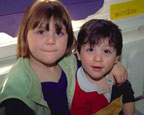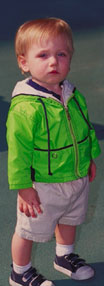 |

Ken Hammond, USDA
The National Child Abuse and Neglect Data System (NCANDS) is a federally sponsored effort that collects and analyzes annual data on child abuse and neglect. The data are submitted voluntarily by the States, the District of Columbia and the Commonwealth of Puerto Rico. State laws determine what is considered abuse, maltreatment or neglect in each state and these laws can vary from state to state. The information that is collected in each state also varies.
The reader is requested to remember that the data presented here are provided voluntarily by each state and compiled by NCANDS. The first report from NCANDS was based on data for 1990; the most recent report, Child Maltreatment 2010, published in 2012, reports on data collected from October 1, 2009 through September 30, 2010. Most of the statistics in this course come from the US Department of Health and Human Services, Administration for Children and Families' Child Maltreatment 2010 (USDHHS-ACF, 2012).
The National Picture
Nationwide, an estimated 754,000 children were victims of abuse and neglect in 2010, a victimization rate of 10.0 for every 1,000 children in the country, according to Child Maltreatment 2010. A child was counted each time he or she was found to be a victim; the adjusted estimate is 688,251 unique child victims (USDHHS-ACF, 2012).
The 2010 victimization rate is the lowest it has been in the previous seven years. While this is the fourth year that the number of victims has decreased, it is not possible to tell whether this year’s decrease indicates a trend until more data are collected. The decrease can partially be attributed to several factors, including the increase in the number of children who received an unsubstantiated disposition, the increase in the number of children who received an alternative CPS response, and the decrease in the number of children who received a substantiated or indicated disposition. Compared to 2009, the number of substantiated victims decreased by 1.2 percent. States investigated or assessed 3,600,000 children because of suspected abuse or neglect, the same estimated total as 2009.
It is possible that the lower rate of victimization in 2010 is related to States’ use of an “alternative response”, as mentioned previously. This alternative approach may be called alternative response, family assessment response (FAR), or differential response (DR). Cases assigned this response often include early determinations that the children have a low-risk of maltreatment. This response usually includes the voluntary acceptance of CPS services and the mutual agreement of family needs. Such cases do not usually make a specific determination of the allegation of maltreatment. However, in cases where services are required by the agency rather than provided solely on a voluntary basis, some States also use the concept of a victim..
Child neglect continues to comprise the largest portion of cases of child maltreatment. According to the federal report Child Maltreatment 2010, of those substantiated reports, figures for the US include:
Neglect
Physical abuse
Sexual abuse
Psychological maltreatment
Medical neglect
Other types |
78.3%
17.6%
9.2%
8.1%
2.4%
10.3%
|
“Other types of maltreatment” include, for example, abandonment, threats of harm, or congenital drug addiction. States may code any condition that does not fall into one of the main categories-physical abuse, neglect, medical neglect, sexual abuse, and psychological or emotional maltreatment as "other." These maltreatment type percentages total more than 100 percent because children who were victims of more than one type of maltreatment were counted for each maltreatment (USDHHS-ACYF, 2012).
Child fatalities are the most tragic consequence of maltreatment. In 2010, an estimated 1,560 children died as a result of abuse or neglect, 2.07 of every 100,000 children in the population. This is a 11.9 percent decrease from the 1,770 fatalities that occurred the previous year. Children younger than 1 year old accounted for 47.7 percent of fatalities, and 79.4 percent of fatalities were children younger than 4 years old (USDHHS-ACF, 2012).
Characteristics
of Child Victims
Generally, the rate of victimization was inversely related to the age group of the child; the youngest children had the highest rate of victimization. Children younger than 1 year had the highest rate of victimization at 20.6 per 1,000 children in the population of the same age (USDHHS-ACYF, 2012). Children younger than 4 years are the most vulnerable for many reasons, including their dependency, small size, and inability to defend themselves. Female children had a slightly higher rate of victimization, 51.2 percent, than male children at 48.5% (USDHHS-ACYF, 2012).
White children had the highest rate of maltreatment; 44.8% of child victims were classified as White; 21.9% of victimized children were classified as African-American; 21.4% were classified as Hispanic. Pacific Islanders had the lowest rate of child victimization, with a rate of 0.2%; Asian children had a rate of 0.9% of maltreatment (USDHHS-ACYF, 2012).
Sixteen percent of victims were reported as having a disability. Children with the following risk factors were considered as having a disability: mental retardation, emotional disturbance, visual or hearing impairment, learning disability, physical disability, behavioral problems, or another medical problem. Children with risk factors may be undercounted as not every child receives a clinical diagnostic assessment. Nearly 4 percent (3.9%) of victims were reported as having behavior problems, 3.2 percent of victims were emotionally disturbed, and another 5.2 percent of victims had some other medical condition. A victim could have been reported with more than one type of disability (USDHHS-ACYF, 2012).
Fifty-one States reported a total of 1,537 fatalities in 2010. In the previous year, 2009, there were 1,750 reported child fatalities from maltreatment. The national fatality rate per 100,000 children in the population was 2.07 for 2010 compared with a national fatality rate of 2.32 for 2009 (USDHHS-ACYF, 2012).
The vulnerability of the youngest victims also is demonstrated by the rates of child fatalities. Children younger than 1 year died from child abuse and neglect at a rate of 17.89 per 100,000 children younger than 1 year in the population. Child fatality rates generally decreased with age. The child fatality rate of children in the age group of 16–17 was 0.34 per 100,000 children in the population of the same age group (USDHHS-ACYF, 2012).
Boys had a higher child fatality rate than girls at 2.51 boys per 100,000 boys in the population. Girls died of abuse and neglect at a rate of 1.73 per 100,000 girls in the population (USDHHS-ACYF, 2012).
Nearly 90 percent (88.3%) of child fatalities were comprised of African-American (28.1%), Hispanic (16.6%), and White (43.6%) victims. Children of American Indian or Alaska Native, Asian, and Pacific Islander racial categories collectively accounted for 1.7 percent of child fatalities (USDHHS-ACYF, 2012).
Reporters of Child Maltreatment
For 2010, of all the reports of child abuse, 58.6% were made by professionals. The term professional means that the person had contact with the alleged child maltreatment victim as part of the report source’s job. “Other” and unknown report sources submitted 13.7 percent of reports. An “other” report source includes any State code that does not fit into one of the NCANDS codes. The remaining reports were made by nonprofessionals, including friends, neighbors, and relatives (USDHHS-ACF, 2012):
The percentages of report sources were from the following professionals:
- Teachers (16.4%),
- Law enforcement and legal personnel (16.7%),
- Social services staff (11.5%),
- Medical personnel (8.2%),
- Mental health personnel (4.5%),
- Child daycare providers (0.7%), and
- Foster care providers (0.5%).
Almost 28% of reports were made by non-professionals:
- Anonymous sources (9.0%),
- Other relatives (7.0%),
- Parents (6.8%), and
- Friends and neighbors (4.4%), and
- Victims (0.4%).
In New York State
In 2010, 79,668 New York State children were abused or neglected, according to the NYS Central Register of Child Abuse and Maltreatment (the Child Abuse Reporting Hotline)—a victimization rate of 18.0 for every 1,000 children. 170,224 reports of suspected child abuse or neglect, involving 223,340 children were received. Upon investigation, 51,701 reports (30 percent) were substantiated as situations of child abuse and/or neglect. There are more victims than reports because more than one child is involved in some cases. Compared to the prior year, the number of reports increased 1.6 percent, from 167,573; the number of substantiated reports decreased 2.1 percent, from 52,792; and the number of victims decreased 3.1 percent from 82,256 (PCA-NY, 2010).
Of the 79,668 children who were abused or neglected in New York State in 2010 (PCA-NY, 2010):
Neglect
Physical Abuse
Sexual Abuse
Psychological Maltreatment
Medical Neglect
Other Types
|
106.6%
11.4%
3.5%
0.9%
5.7%
32.0%
|
Note: Totals are more than 100 percent because a child may be the victim of more than one type of maltreatment. "Other types of maltreatment" include, for example, abandonment, threats of harm, or congenital drug addiction (PCA-NY, 2010).
In New York State in 2010, 114 children died as a result of abuse or neglect, a fatality rate of 2.58 per 100,000 children, according to Child Maltreatment 2010. This is a 4.4 percent increase from 109 fatalities that occurred in 2009 (PCA-NY, 2010).
In New York State, there were a total of 159,556 reports of child abuse and maltreatment to the State Central Register (SCR). Of those reports, 59.6% were made by professionals. Among the following professional groups are the number of reports and percentage of the total of reports by professional groups is as follows (USDHHS-ACF, 2010):
- Educational personnel 32,466 (20.3%);
- Law enforcement/legal 17,637 (11.1%);
- Social services personnel 32,688 (20.5%);
- Medical personnel 9,703 (6.1%);
- Child care providers 404 (0.3%);
- Foster care providers 2,104 (1.3%).
Compared to data from 2009, in 2010 the number of reports increased 1.6 percent, from 167,573; the number of substantiated reports decreased 2.1 percent, from 52,792; and the number of victims decreased 3.1 percent from 82,256 (PCA-NY, 2010).

Ken Hammond, USDA
Continue on to
|
 |